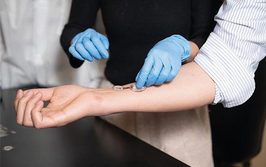Discover how Bristol-Myers Squibb uses electron-activated dissociation (EAD) to confidently identify drug metabolites and localize site of metabolism.
sponsored by SCIEX
During drug metabolite identification (Met ID) studies collision-induced dissociation (CID) is the most commonly used fragmentation technique for LC-MS experiments. Many conjugation metabolites are found to have multiple bonding potentials to parent drugs. It is a great challenge to locate the bonding sites by CID due to the information lost by highly selective cleavage on these bonds.
The novel electron-activated dissociation (EAD) is a recently developed technology on the SCIEX ZenoTOF 7600 system. From a single LC-MS/MS experiment CID and EAD data can be collected, providing information rich fragmentation spectra. The additional information can help in confident localization and identification of metabolites compared to CID alone. These fragments can be crucial to locate the metabolic modification sites, such as conjugations.
In this study, the application of EAD in drug metabolite profiling is explored. The efficiency in the structural elucidation of conjugation metabolites is compared with that of CID.
Webinar Learning Objectives:
- Learn how EAD can be advantageous in confident identification and localization of drug metabolites
- Discover the sensitivity of the Zeno trap technology in the identification of the low abundant metabolites
- Explore the capabilities of the Molecule Profiler software in processing EAD and CID data for drug metabolite identification

















